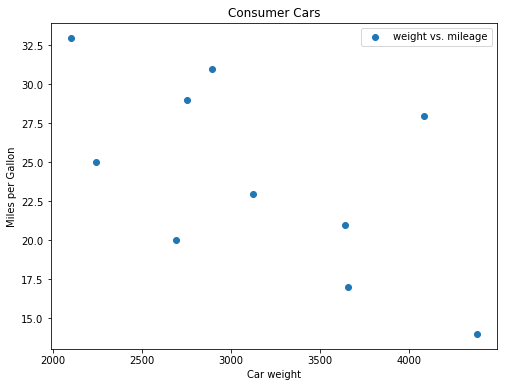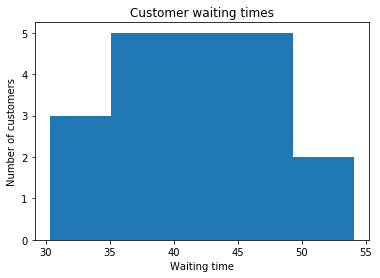This lab will give you some structured practice working with the concepts introduced in the previous lesson.
You will be able to:
- Understand matplotlib plot structure for drawing basic plots.
- Visualize data using scatterplots, barplots and histograms
Make a vertical bar graph using plt.bar() for the following set of data:
Jim's Video Library contains 40 crime/mystery, 30 science fiction, 10 drama, 50 comedy, 25 action and 5 documentary movies.
- Set a figure size of 8x6 inches
- Set x-axis (genres) and y-axis (number of movies)
- Plot and label the bar graph
- Provide a suitable title
- Label x and y-axis
# import the required libraries
import numpy as np
import matplotlib.pyplot as plt
y = None
x =None
labels = None
# Set a figure size
# Plot vertical bars of fixed width by passing x and y values to .bar() function
# Give a title to the bar graph
# Output the final plotThe table shows the data collected by a Consumer Products Group on the relationship between the weight of a car and its average gas mileage.
Car Type Weight miles per gallon
A 2750 29
B 3125 23
C 2100 33
D 4082 18
E 2690 20
F 3640 21
G 4380 14
H 2241 25
I 2895 31
J 3659 17
- Use a scatter plot to show the relationship between mpg and weight of a car.
- Set an appropriate figure size, labels for axes and the plot.
- Give a title to the plot
Looking the scatter plot, how would you describe the relationship between these two attributes?
weight = None
mpg = None
# Set the figure size in inches
# Plot with scatter()
# Set x and y axes labels and give titlesJoe is the branch manager at a bank. Recently, Joe been receiving customer feedback saying that the waiting times for a client to be served by a customer service representative are too long. Joe decides to observe and write down the time spent by each customer on waiting. Here are his findings from observing and writing down the wait times (in seconds), spent by 20 customers:
43.1, 35.6, 37.5, 36.5, 45.3, 43.4, 40.3, 50.2, 47.3, 31.2, 42.2, 45.5, 30.3, 31.4, 35.6, 45.2, 54.1, 45.6, 36.5, 43.1
- Build a histogram of these values using the
hist()function - Plot, label and give a title as above. Use
bins=5 - Briefly describe the output in terms of waiting times.
x = None
#Plot the distogram with hist() function
# Label, give title and show the plotHopefully this lab has given you some good practice working with creating plots in Python using Matplotlib.


